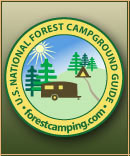Forest Information
The Klamath National Forest is located in northern California and southern Oregon. In California, the Forest is comprised of 1,682,402 acres, while in Oregon there are 26,334 acres. Of 37 developed campgrounds, 12 meet the selection criteria, all of which are in California. Three additional campgrounds are administered by the Six Rivers National Forest.
Some might think the Klamath National Forest is a forest that doesn't want to be discovered but it is too late. The word got out when people learned about the wonders of this little forest. Water is the reason and foundation of the Klamath National Forest. The Klamath and Salmon rivers are the Forest's two primary waterways but its many lakes and creeks add to the growing reputation of the Klamath National Forest as a place for
recreational fun and adventure.
The Klamath River, which begins in Oregon and runs through Northern California, is a whitewater enthusiasts dream. The Klamath River, as it flows through the Klamath National Forest, has ten river put-in/take-out points offering all types of boating opportunities. There are the wild whitewater sections, like the run from Coon Creek to Green Riffle with its Class II+ difficulty rapids, that challenge all. And there are more placid
stretches of river, such as the small section beside Curly Jack
campground, which offers more family-float experiences. Actually, Curly Jack campground, in the recreation centered community of Happy Camp, is a good base for all types of water recreation. Two other aspects of Curly Jack campground some might not consider are its sunnier campsites, which allow waterlogged equipment a chance to dry out, and the convenience of assorted restaurants in town for a cook's night out.
Another potential base camp for Klamath River enthusiasts is O'Neil Creek campground. Where Curly Jack campsites are in a sunny stand of oak, O'Neil Creek sites are tucked into a dense stand of mandrone, cedar, Ponderosa pine, and Douglas fir. While O'Neil Creek campground is adjacent to State Route 96 and traffic noises can be heard in the campground, there is a sense of wilderness provided by the mature trees and rustic environment.
Continuing east, along the Klamath River on State Route 96, visitors to Klamath National Forest will discover an unique and special place Tree of Heaven campground. Named for a tree legend says the Asian emigrants brought to the area, the Tree of Heaven campground boasts a variety of wide canopy, shade producing trees, a groomed grass understory, and a lazy stretch of the Klamath River. A fish-cleaning station and a "put-in" located with the campground add to the attractiveness of the Tree of Heaven.
The Salmon River (called by locals Cal-Sal to distinguish it from the Salmon River in Idaho) is famous for its springtime flow when whitewater enthusiasts challenge the river's raging flow. It is somewhat appropriate that, while the roadway along Klamath River is a nicely maintained paved, two-lane roadway, the road paralleling the Salmon River and its North and South forks are more challenging dirt roads with several "white-knuckle" single-lane passages. Along this challenging, and occasionally nail-biting roadway, are some surprisingly delightful campgrounds, such as Idlewild campground that is also convenient to the Marble Mountain and Russian wildernesses trailheads.
A third river that is important to the Klamath National Forest but doesn't get much notice is Scott River. The Scott River flows from the Klamath National Forest into rich ranch land around Fort Jones. Up where the Scott River flows fast and clear is a pleasant little campground called Indian Scotty. With one loop beside the river and a second loop above, this campground has almost two personalities. But both loops offer well-shaded sites with good privacy close enough to the river to enjoy its
many offerings.
If a Forest visitor's interest is less on water and more are seeing the Klamath National Forest up close and maybe exploring a portion of the Pacific Crest Trail (PCT) , Grider Creek campground is the place to head. Far from everything, this little campground offers through-hikers a small break from the trail and chance for campers to experience a touch of the solitude and challenge found on the PCT.
Still waiting be to discovered are Kangaroo Lake and Juanita Lake. PCT through-hikers probably have enjoyed the 25-acre Kangaroo Lake and its campground. Some might say Kangaroo Lake
has possibly the best walk-in tent sites found in the Forest. Kangaroo Lake, one of the few high mountain lakes accessible by car, also boasts campsites with breath-taking views.
Juanita Lake does not have the elevation of Kangaroo Lake but, at almost double the size, it offers as many recreational opportunities. The Juanita Lake campground is located in a pleasant stand of Ponderosa pine, cedar with, in some cases, a view of the lake. While Juanita Lake appears to be great for canoeing, it is the variety of fish found in the lake that is special. Here, the youngest to the more experienced anglers will find a challenge. And when fishing has lost its interest, visitors can look up for a colorful Western Tanger or sight the local Bald eagle.
The Klamath National Forest isn't a very large forest. It is certainly not a better known forest but it is a forest waiting to be discovered and explored by more than just whitewater enthusiasts. Come and discover all the Klamath National Forest has to offer.
ADDRESSES
SUPERVISOR OFFICE
1711 S. Main St.
Yreka, California 96097
530-842-6131
RANGER DISTRICT ADDRESSES
Goosenest
37805 Hwy. 97
Macdoel, California 96058
530-398-4391
Happy Camp
P.O.B. 377
63822 Highway 96
Happy Camp, California 96039
530-493-2243
Salmon/Scott River
11263 N. Hwy. 3
Fort Jones, California 96032-9702
530-468-5351 |
